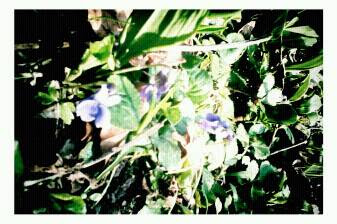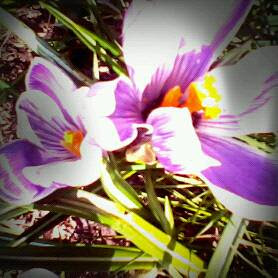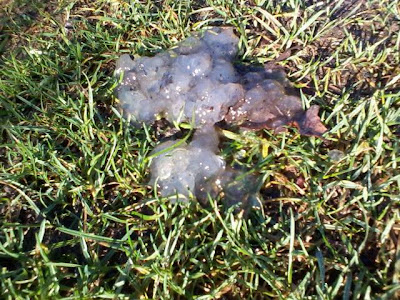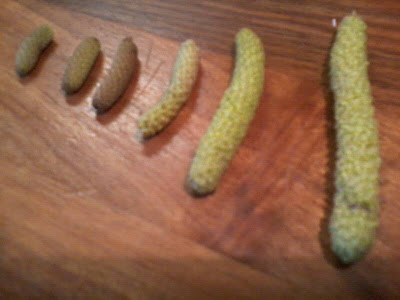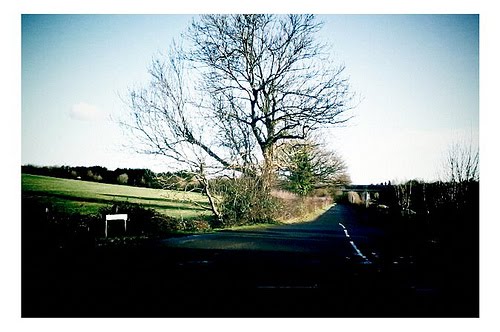
"Nature is so full and varied that if you want to find the place with the most variety, it is the place you most study. Just take in a small piece of land and examine it hard enough." Gilbert White... Long Road, a few miles from Selborne where the pioneering 18th century naturalist lived and documented the flora and fauna of his area. Long Road is our patch, the place to watch the time and seasons come and go, to listen, think and learn
Wednesday 30 March 2011
Foraging Season
This is one of my favourite times of year for foraged food - and there are all sorts of goodies on Long Road. I am yet to collect some of the violets which are currently carpeting the scrub area at the end of the road and make the delicious recipe below but I have had a chance to collect some wild garlic leaves. We have always relied on Richard Mabey's book Food for Free for advice and identification guides - as it can be easy to muddle up wild garlic with poisonous lords and ladies before either is in bloom. Although the pungent garlicky smell when you rip a leaf really is the the best way to tell. After collecting and washing it tends not to keep for more than 24 hours in the fridge so its best eaten straight away or works fine when I've used it from frozen. Here is what I cooked up with it last night which went down a treat with the kids & J:
Fresh Pasta
Fry up:
Onions (Caramelise for 20 mins or so)
Butternut squash & carrot (cut into batons)
Tenderstem Broccoli
3 big handfuls of wild garlic leaves
A little Pasata ( I like mine with a bit of chili but have to add that to my own at the end or I get howls of "too spicy!")
Garnish:
Vegebacon in thin slivers
Parmezano
Sundried Tomatoes
yum!
Now I'm eyeing up the young nettle patches on Long Road too, for next the foraging raid.
Lovely article by Richard Mabey on the joy nature brings him.
"At the age of four I ran wild in an abandoned scrap of land behind my house. It was where my understanding of the wild came from and where I did my first foraging. I began to appreciate how a piece of the earth could have symbolic significance."
Monday 28 March 2011
Going to try this recipe asap!
Vegan and Gluten Free Moist Banana Loaf with Sweet Violets
Hayley Harland |
Monday, 28th March 2011
Use a widely available foraged food to jazz up an easy, healthy and delicious fair trade pudding.

For more gluten free cooking and home grown recipes, visit Hayley's Blog, the Delectable Diary
This common English flower is often known as an uninvited guest on pristine lawns, but I love it. You could say it tastes similar to a perfumed sweet carrot but really it just tastes like... violets. It is medicinally used in India to cure sore throats or tonsillitis and the French use it to make syrup to put in scones, marshmallows and macaroons but why mash this gorgeous thing up to flavour something when it is beautiful and tasty as a decoration freshly picked? It will look like your cakes and pastries have been adorned with many tiny purple orchids and everyone will want a slice.
Some people may nay-say this loaf because its gluten free AND vegan but really those are just added bonuses. The buckwheat flour adds so much flavour and there is no need to use eggs or butter for binding and moisturising as the bananas do all the work for you!
- 2 handfuls of sweet violet flower heads
- 4 or 5 ripe fair trade bananas
- 2 apples
- 1 cup of walnuts
- ½ a cup of muscovado sugar
- ½ a cup of caster sugar
- 2 cups of buckwheat flour
- 1 tsp of bicarbonate of soda
- ½ tsp grated nutmeg
- 1 tsp cinnamon
- ½ cup of water
The glaze:
- The juice of half a lemon
- 1 heaped tbsp icing sugar
Preheat the oven to 175ºC and line a loaf tin with greaseproof paper and a thin layer of olive or rapeseed oil.
In a large bowl, mash your bananas with the sugars until it becomes creamy and well mixed. Add half the flour and mix, then add the second half and spices. Stir in the water then gradually add the soda, mixing as you go. Fold in the apples and walnuts and spoon into the baking tin. Score the top with a knife to allow it to rise and bake straight away for 1 hour.
Pour over your glaze and scatter the violets.
Monday 21 March 2011
Wednesday 16 March 2011
Wednesday 23 February 2011
Sunday 20 February 2011
Monday 14 February 2011
Mysterious Jelly
Found this on the way in this morning...what is it?...fungus, bird vomit, ectoplasm or unspawned frog spawn?..answers on a postcard please
Published with Blogger-droid v1.6.7
Monday 7 February 2011
Candlemas Day
I'm always intrigued by folk tales about nature and particularly ones relating to weather - red sky at night, St.Swithun's Day, cows lying down etc and their their bearing on reality. Whether they are relevant or not I can't help sharing them with the bemused children. Today I read a new folk tale based around the weather on Candlemas day by Paul Brown in the Guardian...
There was a brief moment of sunshine on Candlemas Day – 2 February – but any animal emerging from hibernation would have been lucky to surface at the right moment to see its shadow.
According to folklore then, the worst of the winter is over. The date is significant because it is half way between the winter solstice and spring equinox. In both heathen and Christian calendars it is a day for lighting candles and celebrating the return of the light. There are many weather rhymes associated with the festival. All have the same theme: sunny and cold is bad news, windy and wet is good. "If Candlemas Day be fair and bright, winter will have another fight. If Candlemas Day brings cloud and rain, winter won't come again", is perhaps the best known.
The Irish have a Gaelic hag who can make 2 February sunny so that she can gather plenty of sticks for her fire for the rest of a long winter. If she forgets to do this or oversleeps the weather is wet and windy, thus bringing winter to a rapid end because of her lack of firewood.
The story about the animal spotting its shadow comes from a German tradition about badgers. They immediately return for another sleep if it is sunny on 2 February because they know the winter will continue. Despite lack of badgers this tradition crossed the Atlantic and became Groundhog Day. It is all completely unreliable, but surprisingly consistent across Europe and North America.
So if the legend is right winter is not quite over yet. Curiously I did see some rustling movement in the undergrowth on Long Road last week, followed it and found a little brown mouse staring boldly at me from the inside of a log, I thought he might have come out of hibernation early, only to discover mice don't hibernate...but do tend towards human habitation when its cold....maybe he should have headed back.
Friday 4 February 2011
Thursday 3 February 2011
Catkins
Catkins collected from Long Road this morning....demostrating the differences in temperature and light along the road. Most impotantly showing signs of Spring on the way
Published with Blogger-droid v1.6.6
Sunday 30 January 2011
Big Garden Birdwatch
About your birdwatch
| 0-7 years | 1 |
| 8-14 years | 0 |
| 15-18 years | 0 |
| 18+ years | 1 |
| Location of birdwatch | Garden |
Common birds
| Blackbird | 4 | |
| Blue tit | 4 | |
| Chaffinch | 3 | |
| Coal tit | 1 | |
| Dunnock | 2 | |
| Goldfinch | 6 | |
| Great tit | 2 | |
| House sparrow | 3 | |
| Jackdaw | 3 | |
| Robin | 1 | |
| Starling | 3 | |
| Woodpigeon | 4 | |
| Wren | 1 |
Scarcer birds
| Blackcap | 1 | |
| Pied wagtail | 1 |
Wednesday 19 January 2011
Bird TV
Due to almost every member of the family suffering from flu over December, we became rather frustratingly housebound. We were saved our sanity, in part, by the fact that our living room has large glass doors and looks into the garden, the garden feels like and extension of the living room. In the garden we have a bird table constantly topped up, several feeders and various coconuts hanging from the trees - creating Bird TV - a freeview channel, with plenty of drama and great characters.
During our first few years living here we had a real dearth of birds in the garden - in fact apart from a family of very vocal and bossy blackbirds and the odd wood pigeon plumping down for a look around, everything else seemed to fly overhead and actively avoid our garden. I put that down to the fact that there had been several generations of cats living here prior to us. I chatted to neighbours who thought I was probably right but had noticed a decline in the bird population ever since an estate had been built on a nearby green field site. It was also suggested that I have a look in their gardens at what feed worked for them. Well, it took nearly two years of coaxing and wasted food but finally we have constant feathered visitors.
The first to be tempted back in were the goldfinches, who I'd seen hanging around in the chestnut trees at the back of us - watching and waiting - they are very fussy and only take (expensive!) niger seed from only one feeder, placed on exactly the same branch every time. Now they queue for it in our garden trees, with a bit of pushing and shoving. Any bits thats fall to ground are rarely hovered up by them but has attracted numerous skittish chaffinches.
"Fat balls are needed for tits" I was reliably informed by friends and websites, did they take any notice? - no - the tits sat and looked disdainfully at the round offerings hung here and there. It was only one day whilst making dumplings for a stew with vegi suet that I wondered if...if..I put few sprinkles on the bird table and a few in a feeder and to see what would happen....literally within minutes blue tits, coal tits and great tits arrived for the suet and have stayed ever since, eating spiders and making nests in the hedges. They now also deign to take from coconuts. Two weeks ago I fitted a peanut window feeder to the kitchen it is visited mainly by blue tits, delighting the children who get to see them close up.
...and so it went on black caps also like the suet, robins black sunflowers seeds and a family of cheeky starlings - anything! We even had a brief glimpse at a flock of waxwings in December who wheeled in stripped a bush of berries in a matter of minutes and wheeled out again - even more delight from children and adults that time.
It was commented on that I was out feeding the birds before the children in the snowy spell, but hey the demands of Bird TV, and hopefully helping out these beautiful creatures are well worth it.
Subscribe to:
Posts (Atom)

